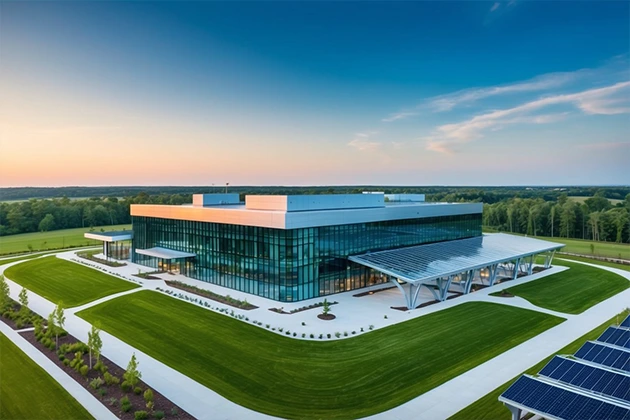Steel innovations are reshaping the commercial real estate sector by introducing new architectural possibilities and boosting sustainability. Advanced steel technologies allow for the construction of taller buildings with lighter frameworks, offering more interior space and flexibility in design. These advancements make it possible to meet urban density demands while maintaining safety and efficiency.
Innovative steel solutions enhance the energy efficiency and environmental impact of commercial properties, contributing to significant cost savings over time. The development of recycled and high-performance steels reduces the carbon footprint of construction projects. Steel’s durability and adaptability also offer long-term benefits for maintaining and retrofitting existing structures.
The integration of smart technologies with steel structures further revolutionizes the industry. Digital tools enable real-time monitoring and maintenance, ensuring structural integrity and reducing lifecycle costs. These innovations attract investors and developers aiming to future-proof their properties and remain competitive in a rapidly evolving market.
Impact of Steel Innovations on Design and Construction
Recent advancements in steel technology are reshaping both design and construction practices. These innovations are driving a shift towards more efficient and sustainable building methods, increasing design flexibility and enabling faster construction timelines.
Revolution in Building Materials
Steel innovations have introduced new materials with enhanced strength and durability. High-performance steel grades are being developed to provide better resistance to environmental factors like corrosion and thermal expansion. This allows for longer-lasting structures that require less maintenance over time.
Barndominium kits are one example of how these materials are used. These kits offer a cost-effective approach to creating residential and commercial spaces that combine living and storage areas under one roof. The versatility of steel enables sophisticated architectural designs that integrate seamlessly with modern styles.
Prefabricated Elements and Modular Construction
Steel’s adaptability has led to a rise in prefabricated and modular construction. Components are manufactured off-site, allowing for faster on-site assembly and reduced construction time. This method also minimizes labor costs and on-site waste.
Architects can rely on the precision of prefabricated steel elements to achieve intricate designs that were once challenging with traditional methods. Modular construction benefits from steel’s strength, enabling buildings to be assembled quickly without compromising structural integrity. This approach is particularly effective in urban areas where speed and efficiency are critical.
Sustainability and Environmental Benefits
Steel innovations are reshaping commercial real estate with impressive sustainability and environmental benefits. These advances boost energy efficiency and promote reduced waste and recyclability, aligning with modern eco-conscious goals.
Energy Efficiency Advancements
Steel plays a crucial role in improving the energy efficiency of commercial buildings. High-performance steel framing systems contribute to better insulation and minimal thermal bridging, reducing energy loss. By providing excellent strength-to-weight ratios, steel frames allow for expansive windows facilitating natural light, which can decrease the need for artificial lighting.
The incorporation of advanced steel technologies supports the integration of renewable energy systems, such as solar panels, on rooftops. This ability to generate on-site clean energy further optimizes energy use. Additionally, steel’s durability reduces the frequency of renovations, decreasing material and energy consumption over the building’s lifecycle.
Reduced Waste and Recyclability
Steel is renowned for its recyclability, making it a sustainable choice in construction. The material can be recycled multiple times without losing its strength or integrity. This capability substantially lowers construction waste, mitigating landfill contributions. Many steel manufacturers are adopting practices that use recycled steel in new products, enhancing their eco-friendliness.
Prefabrication of steel components minimizes onsite waste. By producing parts in regulated environments, fewer errors occur, which reduces material discard. Moreover, the precision of prefabrication leads to efficient construction timelines, reducing the overall environmental impact. This combination of reduced waste and enhanced recyclability makes steel a valuable asset in sustainable development practices.
Economic Advantages for Stakeholders
Steel innovations in commercial real estate lead to significant economic benefits. They cut construction costs and extend building lifespan, enhancing stakeholder value.
Cost-Effectiveness of New Steel Technologies
New steel technologies reduce costs through increased efficiency and resource conservation. Advanced manufacturing techniques, such as modular construction and prefabrication, lower labor and material expenses. These technologies facilitate faster assembly times and minimize waste. In commercial projects, these savings translate into more competitive pricing and larger profit margins.
Barndominium kits are an example of cost-saving steel solutions for commercial properties. They offer a streamlined assembly process with quality control. Stakeholders gain from lower financing costs due to shorter construction timelines and decreased risk of overruns.
Long-Term Maintenance and Durability
The durability of modern steel extends the lifespan of buildings, offering substantial long-term savings. Steel’s resistance to rust, pests, and natural disasters minimizes repair needs and maintenance expenses. Enhanced coatings and treatments further increase its resilience, ensuring stable structural integrity over decades.
For stakeholders, this durability translates into predictable costs and reduced frequency of capital-intensive repairs. Structures like barndominiums benefit from these attributes, providing a cost-effective solution for long-lasting buildings. Insurance costs may decrease as well, due to the reduced risk associated with steel’s robust properties.
Case Studies and Real-World Applications
Innovations in steel technology are having a profound impact on commercial real estate. This section explores notable projects and evaluates measurable performance advantages.
Commercial Projects Utilizing Steel Innovations
Several commercial structures worldwide showcase cutting-edge steel technologies. The Shard in London uses steel extensively, allowing for a slender, aerodynamic design that optimizes energy efficiency. In New York, the Hudson Yards development features high-strength steel, enabling expansive floor-to-ceiling windows that enhance natural light without compromising structural integrity.
In Tokyo, the Mode Gakuen Cocoon Tower employs a steel exterior that supports unique curvatures, maximizing both aesthetic appeal and space efficiency. These advancements allow architects to push creative boundaries while adhering to stringent building codes and sustainability standards.
Benchmarking Performance Improvements
Steel innovations contribute significantly to improvements in building performance. Strength-to-weight ratios of new steel composites result in lighter structures with increased load-bearing capacity. This leads to material cost savings and greater design flexibility.
Energy efficiency benefits are notable, with advanced steel framing systems reducing thermal bridging, thus lowering HVAC demands. Enhanced durability extends building life cycles, reducing long-term maintenance costs. Safety features are improved as well, with steel’s resilience in earthquakes and fires providing peace of mind for occupants and investors alike.
Projects like these underscore the value of incorporating advanced steel solutions in modern commercial architecture.










